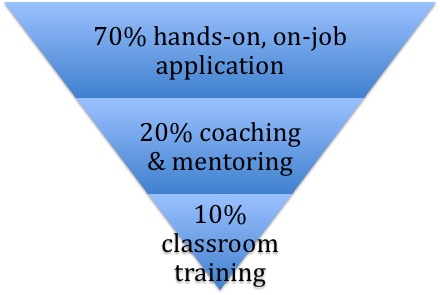Our experience with the 70:20:10 Rule
The 70:20:10 rule of training and development was created by the Center for Creative Leadership back in the 1980s. It has been debated and contested but has stood up pretty well over the past 30 years.
At its most basic terms the rule is that:
- 10% of learning comes from formal training programs
- 20% is from coaching and mentoring, often by managers
- 70% happens through hands-on, on-the-job experience
 We’re in the training business so you’d think we’d spent a lot of time refuting the 70:20:10 rule. But our experience is that the rule is very accurate. So rather than fight it to protect our turf, we’ve adapted our delivery so clients can get real benefit from the services we provide so their employees use our processes. Here’s how:
We’re in the training business so you’d think we’d spent a lot of time refuting the 70:20:10 rule. But our experience is that the rule is very accurate. So rather than fight it to protect our turf, we’ve adapted our delivery so clients can get real benefit from the services we provide so their employees use our processes. Here’s how:
Formal training – We still use classroom training but we minimize the amount of time participants spend in the classroom. With more Millennials entering the workforce with a preference for shorter blocks of learning, we tailor our approach to this learning style and provide smaller sections of training. And the time participants spend in the classroom is not overwhelmed with the instructor talking at the participants. A significant amount of the time is dedicated to case studies that reinforce the instructor training by applying it to real-life examples. We also provide tools, such as an Operator’s Problem Report Log, to help participants apply what they learned in the classroom when they return to the job.
Coaching and mentoring – Our most successful engagements include training a group in the client company, that we call Process Coaches (PCs), on how to coach others in using the processes learned in the training program. These PCs receive extensive training in the processes so they have a deeper understanding of how to apply them. They also learn some basic coaching skills so they can effectively counsel others. As we know, coaching is a very specific skill and we want to make sure the coaches have the technical skills and the people skills to be effective.
Hands-on, on-the-job experience – We learned long ago that the best learning happens when people apply what they learn very quickly to real job issues. This is done in part with our case studies, which are pulled from real-life examples. But more importantly, participants in our training programs bring real issues they are facing on the job so they can apply our processes to those issues in the training session. They get breaks from the classroom sessions so they can return to the workplace to gather more information about the issue and dig deeper on issue resolution. The coaches mentioned above can also help the participants in the on-job applications and during follow-up after the training ends.
Rather than being just a theoretical construct, the 70:20:10 Rule has been proven in our work with countless clients in various manufacturing sectors. If you expect real improvement by just doing training programs, you’re likely to be disappointed. By combining classroom learning with the power of coaching, mentoring and application to real job issues, you’ll get the improvements you’re looking for in productivity and quality improvement, as well as higher morale in the workplace.
